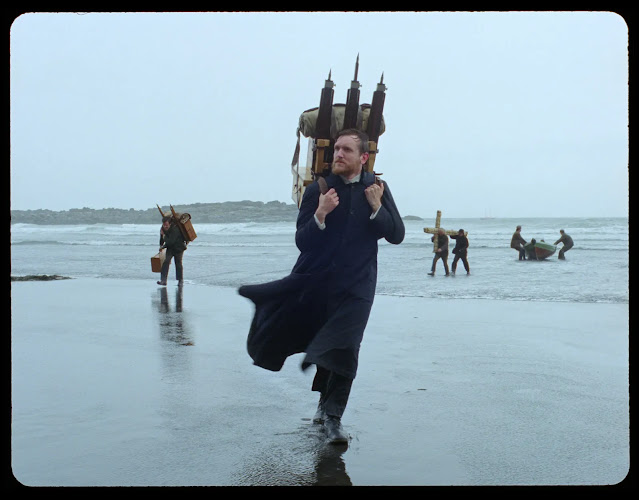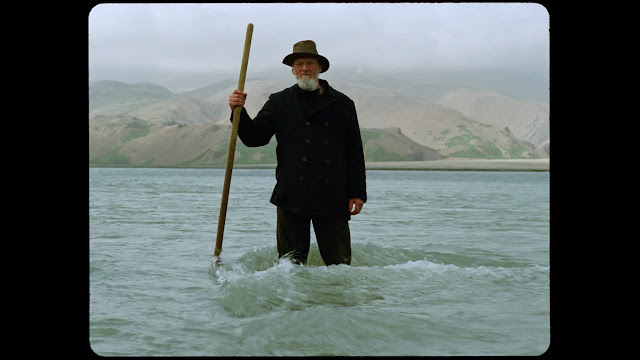You May Have Missed: Godland (Dir Hlynur Pálmason, 2h22m, 2022)
 |
| Godland US Poster. |
Our journey around some of the best films that 2023 offered continues. This week, we're in Iceland, a nation, like Finland, home to an cinematic renaissance
that at first glance, considering its population of 340,000 and 43 cinemas, may seem a surprise. Not necessarily so; Iceland has one of the highest cinematic attendances in Europe, each Icelander seeing over three films a year, and, with 12.6 cinemas per hundred thousand population, is only rivalled by the USA (14 cinemas per hundred thousand). It's thus hardly surprising that Iceland's film industry is, even more than Finland's,
a dominant force in its home country.
Like Finland, Iceland's cinema has broken the confines of its borders since the turn of the 21st century, ranging from early 2000s urban dramas and comedies like Angels of the Universe (Englar alheimsins) and 101 Reykjavik (both 2000), to stark and often surreal films like Noi the Albino (Nói albinói, 2003) and Jar City (Mýrin, 2006), to big-budget Norse epics like Beowulf & Grendel (2005), demostrating the increased popularity of the country as ready made scenery for fantasy kingdoms or alien worlds. In recent years, though, tales of Iceland in the nation's cinema have increasingly
come to focus on the darker side of Icelandic life. Rams (Hrútar, 2015) depicts the fractious relationship between two estranged brothers, whilst the folk horror
film Lamb (Dýrið, 2021) considers the Icelandic wilderness through the figure of a human-sheep hybrid child. Many of these films consider at once
the harshness of Iceland's nature and the hardiness of its people; of these, a few consider them to be extensions of each other, the people and the country capable of great beauty and great brutality.
 |
| Lucas (Elliott Crosset Hove), sets foot on Iceland, camera on his back |
Enter, thus, Hlynur
Pálmason's Godland (Volaða land-wretched, or deformed land), set in the late 19th Century, in which a Danish priest (Elliott Crosset Hove)
arrives in Iceland, to build a church. The film focuses on his battle against its landscape, and, once his perilous trek across the country's interior is at an end, so his struggle against its people, in particular his guide Ragnar (Ingvar
Eggert Sigurðsson), begins, all of this captured through the camera that he carries, almost shrine-like, and whose photographic plates inform the almost square framing that this harsh world of 19th Century Iceland is viewed through.
Through this aperture into the world, so we, and the priest, Lucas, begin in Denmark, where his superior gently warns him about the need to build the church among his flock before winter, before agreeing to have Lucas take
his picture.
The portrait, the photographic staging of scenes recurs several times-most notably in a wordless montage in the last third of the film where the journey unspools itself, travelling back from the village,
the church, and Lucas' congregation, all the way back to this image-and it is immediately apparent that this, alongside his calling, is his true passion, his way of understanding and interacting with the world around him,
as we see. We see the world through a manifestation, a stunningly simple representation of Lucas's view of the world, his plates informing the very aspect ratio, and framing of much of the film. In a way, the entire film is a recapturing of Lucas's photographs and portraits, and the film soon
cuts to a second document of his journey, where, Danish-Icelandic translator in tow (Hilmar Guðjónsson), Lucas photographs the crew of the ship he is travelling on, before being rowed to shore, here meeting with
Ragnar.
Ragnar is Iceland-Ingvar, already perhaps the key figure of Icelandic cinema post 2000 (of the half dozen film listed above, only Noi and Rams does not feature the veteran Icelandic actor in some form), now represents the nation, barely speaking Danish to the priest, often gruffly grumbling under
his breath or singing morbid songs that his charge that he now leads through the country's interior cannot understand. In one of my few detractions from the film's otherwise sublime experience, the subtitling often
blends into one for both languages, leaving it occasionally unclear-and the effect sometimes lost-as to who understands when others speak, and who does not. Ragnar, undeniably, is antagonistic. Ingvar radiates a presence that, as the film reaches the settlement in which Lucas is to preach, becomes positively palpable, a barely restrained menace.
There
is, below the surface, also the sense of the masculine, the powerful to Ragnar, a curious tale he recounts midway through the film, of eels breeding and unsettling dreams of emasculation, compared to the bookish, and often-boyish
priest-in the settlement itself, the film also presents the figure of Carl (Jacob Lohmann), who, whilst more educated, and more refined than the rough figure of Ragnar, is just as inhospitable to the priest, especially once
Lucas becomes too close to his daughter, with catastrophic results. Yet, to an Icelandic audience, he also represents a subjugated people, still years from becoming an independent kingdom, and decades away from true independence
from Denmark in 1944, and this encroaching outsider who ignores his expertise, to tragic and fatal results, is Danish.
His hostility, and, as the film reaches its stark conclusion, his open dislike of Lucas, is nothing compared
to the country itself. This may be passée, as with many films in the wilder places of the world-the film's mad trek across landscapes of volcanoes, glaciers, razor-sharp rocks and torrential rivers calls to mind Aguirre, Wrath of God transposed several thousand miles north-to consider the beautiful and savage Icelandic landscape a character, but a character it is. Iceland is, at once, capable of being beautiful,
one scene beneath a waterfall in which Lucas and the translator admire the ethereal quality of the landscape as Lucas photographs it, and brutal, the priest eventually having a nervous breakdown among its glaciers as his camera
equipment breaks, the shrine-like points of the tripod thrown towards a crevasse as he howls his frustration. It is a momentary, and stark loss of faith in the journey, in its purpose of meeting and depicting the people he aims to preach to.
Iceland
is more than just a presence in the film-it is the entire film-as much as this is a film about Lucas' journey across the country, it is a film about the change of the seasons, of the processes of the natural world. When the colossal cross that the group carry with them is lost in a river crossing, the film cuts to its journey back to the sea several times, whilst the decomposition of a horse, in a sequence that took two years to complete as the Icelandic seasons strip it to the bone in successive jump
cuts. It is in these curious vignettes, almost always devoid of humans, that the soul of the country, the understanding of the people and the nation that Lucas fruitlessly searches for, can be found, rather than in his staged
portraiture.
These sequences also serve another, narrative, purpose. The film's third act is largely set in the village, the wildness of the landscape largely pushed to the background, often simply looming
over the village-the film instead turns to the hostility of Ragnar, and later to Carl, whose own coldness to Lucas is as insidious, and a great deal more alarming presence than Ragnar's own dislike of the Dane. All of
this undercurrents, these uneasy feeling beneath the surface, do in fact manifest as a physical force in the film, both in the form of the groaning metallic score by Alex Zhang Hungtai, and visually, in the darkening
storm-clouds that sweep over the landscape, the erupting volcanos, the savage glaciers, all of these unseen elements prelude the film's descent into violence, and into Lucas' lapses of faith and reason as the hostility
of the country and the people take its toll upon the priest.
There is, undeniably, beauty in Godland; the film is as much a paean to Iceland as it is a chronicle of its harshness
and hostility to the outsider, nimbly balancing this both barren and holy land with the fate of the priest who attempts to capture it with his camera. Godland, though, is more than simply man against nature, but, from one of
the best cinemas in Europe, a superbly made film considering loss of faith, and man's place in nature, in a true Icelandic saga that is savage, vast and breathtaking.
Rating: Highly Recommended
Godland is available to rent online in the UK via The BFI,
and on DVD from Curzon Film. It is also currently available to
stream via Apple TV, and on DVD from Criterion in the USA.
Next
week, the atomic age beckons, with Christopher Nolan's towering, and complex, biopic of the father of the nuclear bomb, Oppenheimer.




Comments
Post a Comment